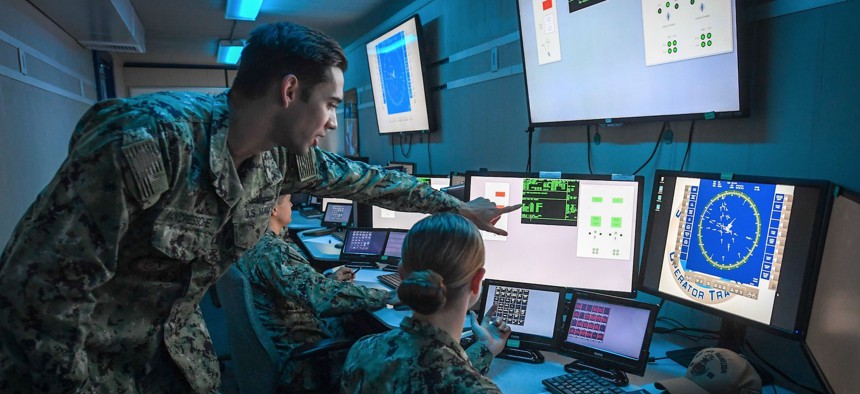LAUREN C. WILLIAMS
 NATIONAL HARBOR, Maryland—The Navy is betting big on simulated training as part of its Live, Virtual, and Constructive training program. But virtual training is not always the best choice, and simulations must be realistic to be valuable, experts say.
NATIONAL HARBOR, Maryland—The Navy is betting big on simulated training as part of its Live, Virtual, and Constructive training program. But virtual training is not always the best choice, and simulations must be realistic to be valuable, experts say.“It's a question of when simulated training is juice that's worth the squeeze. And the reality is that it is not always, but where it is, it really has exquisite capability,” said Schuyler Moore, the chief technology officer for U.S. Central Command, during a panel discussion on the future of all-domain mission rehearsal at the annual SeaAirSpace conference on Monday.
Figuring out that value means determining three things: accessibility, risks, and how much a simulated environment can be tailored to specific training needs, while being as realistic as possible.
“Is it something where you don't want someone up in the air, out on a ship trying something because the risk is too high to consistently run training on the reps and sets that they need?” Moore said. “Do you have access to whatever system or aircraft or platform would allow you to do the training necessary, if not supplemented with simulated training as much as humanly possible?”
Moreover, the value simulated training offers is directly related to how specific it is, she said.
“Doing general simulated training that covers everyone may be generally useful, but specifically useful to no one. And so to the extent that you can very clearly articulate what your environment is and the way that you will be using whatever system that you are training on, the better,” Moore explained.
For example, simulations are perfect for safety training because the risk is too high to put individuals in dangerous scenarios, and space to run those exercises repeatedly in the real world could be limited.
“The access may be a little bit low, because again, what if you're deployed? You may not have the ability to run those types of exercises on a recurring basis—depends on the space available, depends on whether or not you can get into the right space. And then the environment is perfect. Because you know exactly how it's going to run, you know what the inside of the ship is going to look like, you know where you need to place the valves for someone to have an augmented reality experience around that.”
But simulated training environments aren’t always appropriate, like with some unmanned systems, she said.
For example, with “unmanned surface vessels, the risk associated with operations is slightly lower than it might be for other unmanned systems. If an unmanned ground vehicle swerves off the road, that's a serious problem. That is not [an] acceptable risk. But if an unmanned surface vessel or an unmanned underwater vessel veers off course, that risk is slightly more acceptable. And so the question of whether the juice is worth the squeeze for simulation actually comes into question,” Moore said.
Access to unmanned systems for training is a challenge, but the Navy wants to change that as those systems expand to the fleet level. United States Naval Forces Central Command has more than 20 unmanned surface vessels in Bahrain, and “we have gotten pretty clear guidance from the Secretary of the Navy and the Chief of Naval Operations that the intention of the fleet ratio is increasingly going to move in that direction. So access is going to rise,” Moore said.
The Navy has been clear that it plans to invest more in its Live, Virtual, and Constructive training capabilities across the enterprise. And it will be important in preparing for a battlefield where weapons and warfighters are scattered across a region with little connectivity.
“None of our weapons systems work in a vacuum anymore. Everybody's connected together through high-speed data links. It's very important for all of our training audience members to be connected together through those high-speed data links collaborating, using the interactive capabilities of all of these different weapons systems,” John Bell, HII’s technical director for Live, Virtual, and Constructive solutions, said Monday.
In terms of accessibility, having sailors and aviators at sea means that training—beyond just live action—has to come to them. That’s particularly important for Joint All Domain Command and Control, he said.
“When we are doing large-scale exercises, when we are doing joint-service exercises, when we are doing JADC2, it's all about the integration of those C5ISR systems. And if we're going to really use those systems and really exercise them in training, we have to have the training systems fully integrated with those C5ISR systems,” Bell said.
“A lot of times, we'll have a training version of a C5ISR system or just a simulation of that C5ISR system. Back to that concept of distributed, we really need to be able to tightly integrate the trainers to the real-world C5ISR systems, so that we're taking advantage of that global distribution of those systems, and that everybody can train where they are, when they need to, at the right level of training.”
No comments:
Post a Comment